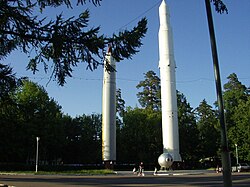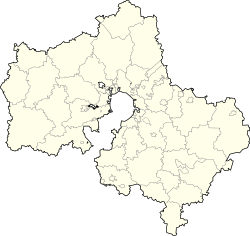Vlasikha, Moscow Oblast
 From Wikipedia - Reading time: 9 min
From Wikipedia - Reading time: 9 min
Vlasikha
Власиха | |
|---|---|
Work settlement[1] | |
 Central square in Vlasikha | |
| Coordinates: 55°41′06″N 37°11′30″E / 55.68500°N 37.19167°E | |
| Country | Russia |
| Federal subject | Moscow Oblast[2] |
| First mentioned | 1646[1] |
| Urban-type settlement status since | August 5, 2009[1] |
| Elevation | 190 m (620 ft) |
| Population | |
• Total | 26,359 |
• Estimate (2023) | 28,401 |
| • Subordinated to | closed administrative-territorial formation of Vlasikha[2] |
| • Capital of | closed administrative-territorial formation of Vlasikha[2] |
| • Urban okrug | Vlasikha Urban Okrug[4] |
| • Capital of | Vlasikha Urban Okrug[4] |
| Time zone | UTC+3 (MSK |
| Postal code(s)[6] | 143010 |
| Dialing code(s) | +7 495, 498 |
| OKTMO ID | 46773000051 |
| Website | vlasiha-zato |
Vlasikha (Russian: Вла́сиха) is a closed urban locality (a work settlement) in Moscow Oblast, Russia. It serves as the headquarters of the Strategic Missile Troops of Russia.[7] Population: 28,240 (2021 Census);[8] 26,359 (2010 Census);[3]
History
[edit]It was first mentioned in the 17th century as the village of Kostino. In 1646, this was the votchina of the widow A. Pushkina. One kholop lived in the estate, and in 9 peasant households there were 30 male souls. The Tsar's father-in-law, boyar Kirill Naryshkin, bought this estate from the Pushkins. By 1678 the village began to be called the Seltso of Kostino. In it and in the neighboring village of Lapino at that time there were 15 peasant households and 55 men.
At the end of the 18th century, the village of Vlasikha was mentioned in the possession of the Moldavian native Prince Alexander Mavrocordatos Firaris. There were 19 male and 25 female souls in 6 households. The manor's two-story wooden house on a stone foundation, with a garden with fruit trees, and a “rusted” mill about one stand are noted.
According to information from 1852, the village was owned by the collegiate assessor Abram Petrovich Khvoshchinsky and there were 23 men and 26 women in his 8 households. In 1890, 63 residents lived here.
In 1928, the leadership of the Red Army decided to organize the Vaccine and Serum Laboratory of the Military Sanitary Directorate of the Red Army, which was engaged in the creation of vaccines and serums for the needs of the army. The laboratory was established by 1930 on the territory of the summer house of the former tea merchant Wahau. On April 16, 1933, the laboratory was reorganized into the Military Scientific Medical Institute of the Red Army, which in 1934 was renamed the Biotechnical Institute of the Red Army. The institute operated in Vlasikha until 1937.
In October 1941, the headquarters of the Western Front was deployed in Vlasikha, from which its commander, Georgy Zhukov, led the defense of Moscow.
In 1958, a command complex with a 4-tier bunker and a residence began to be built in Vlasikha.[9] On January 15, 1960, the Minister of Defense of the USSR, Marshal Rodion Malinovsky signed an order “On the deployment of control bodies of the Commander-in-Chief of the Missile Forces” which ordered: “The main headquarters and directorates of the Commander-in-Chief of the Missile Forces should be located in Perkhushkovo (32 km west of Moscow) on the funds of the military town 22/1".[10]
In 1986, in Vlasikha they began to build a new 12-tier bunker two kilometers from the old one.[9]
In modern Russia, the headquarters of the Strategic Rocket Forces is located in Vlasikha.
By decree of the President of Russia of January 19, 2009 A closed administrative-territorial formation was established on the territory of the closed military townlet #22/1 on January 19, 2009.[11] The ZATO also included the Shkolny microdistrict in the village of Yudino. On June 7, 2009, the first elections of deputies of the Council and the Head of the urban district were held in the Vlasikha urban district. The head of the city district, O. V. Agafonova, and 15 deputies of the Council of Deputies were elected
On August 5, 2009, Boris Gromov, the Governor of Moscow Oblast, issued a Resolution which transformed the military townlet into an urban-type settlement.[1] On October 29, the urban-type settlement was named "Vlasikha".[12]
Administrative and municipal status
[edit]Within the framework of administrative divisions, it is incorporated as the closed administrative-territorial formation of Vlasikha—an administrative unit with the status equal to that of the districts.[2] As a municipal division, the closed administrative-territorial formation of Vlasikha is incorporated as Vlasikha Urban Okrug.[4]
References
[edit]Notes
[edit]- ^ a b c d e Resolution #110-PG
- ^ a b c d Law #11/2013-OZ
- ^ a b Russian Federal State Statistics Service (2011). Всероссийская перепись населения 2010 года. Том 1 [2010 All-Russian Population Census, vol. 1]. Всероссийская перепись населения 2010 года [2010 All-Russia Population Census] (in Russian). Federal State Statistics Service.
- ^ a b c Law #21/2009-OZ
- ^ "Об исчислении времени". Официальный интернет-портал правовой информации (in Russian). June 3, 2011. Retrieved January 19, 2019.
- ^ Почта России. Информационно-вычислительный центр ОАСУ РПО. (Russian Post). Поиск объектов почтовой связи (Postal Objects Search) (in Russian)
- ^ RIA Novosti. Звёздный городок и военный городок Власиха преобразованы в ЗАТО Archived December 11, 2014, at the Wayback Machine (in Russian)
- ^ Russian Federal State Statistics Service. Всероссийская перепись населения 2020 года. Том 1 [2020 All-Russian Population Census, vol. 1] (XLS) (in Russian). Federal State Statistics Service.
- ^ a b "Метро в Одинцове". January 9, 2009. Archived from the original on October 15, 2014. Retrieved October 11, 2014.
- ^ "Ракетной столице России — 50". Archived from the original on October 16, 2014. Retrieved October 11, 2014.
- ^ Decree #70
- ^ Resolution #8/94-P
Sources
[edit]- Московская областная Дума. Закон №11/2013-ОЗ от 31 января 2013 г. «Об административно-территориальном устройстве Московской области», в ред. Закона №249/2019-ОЗ от 29 ноября 2019 г. «О внесении изменений в Закон Московской области "Об административно-территориальном устройстве Московской области"». Вступил в силу на следующий день после официального опубликования (13 января 2013 г.). Опубликован: "Ежедневные Новости. Подмосковье", №24, 12 февраля 2013 г. (Moscow Oblast Duma. Law #11/2013-OZ of January 31, 2013 On the Administrative-Territorial Structure of Moscow Oblast, as amended by the Law #249/2019-OZ of November 29, 2019 On amending the Law of Moscow Oblast "On the Administrative-Territorial Structure of Moscow Oblast". Effective as of the day following the day of the official publication (January 13, 2013).).
- Московская областная Дума. Закон №21/2009-ОЗ от 16 марта 2009 г. «О некоторых вопросах организации местного самоуправления на территории городского округа Власиха Московской области и о внесении изменений в Закон Московской области "О статусе и границах Одинцовского муниципального района и вновь образованных в его составе муниципальных образований"». Вступил в силу через 10 дней после официального опубликования. Опубликован: "Ежедневные Новости. Подмосковье", №52, 19 марта 2009 г. (Moscow Oblast Duma. Law #21/2009-OZ of March 16, 2009 On Various Aspects of the Organization of Local Self-Government on the Territory of Vlasikha Urban Okrug of Moscow Oblast and on Amending the Law of Moscow Oblast "On the Status and the Borders of Odintsovsky Municipal District and the Newly Established Municipal Formations It Comprises". Effective as of the day which is 10 days after the day of the official publication.).
- Губернатор Московской области. Постановление №110-ПГ от 5 августа 2009 г. «Об образовании посёлка городского типа (рабочего посёлка) на территории закрытого военного городка №22/1, преобразованного в закрытое административно-территориальное образование». (Governor of Moscow Oblast. Resolution #110-PG of August 5, 2009 On Establishing an Urban-Type Settlement (a Work Settlement) on the Territory of the Closed Military Townlet #22/1, Which Was Previously Transformed into a Closed Administrative-Territorial Formation. ).
- Президент Российской Федерации. Указ №70 от 19 января 2009 г. «О преобразовании закрытого военного городка №22/1 в закрытое административно-территориальное образование — посёлок Власиха Московской области». Вступил в силу со дня подписания. (President of the Russian Federation. Decree #70 of January 19, 2009 On the Transformation of Closed Military Townlet No. 22/1 into the Closed Administrative-Territorial Formation—the Settlement of Vlasikha of Moscow Oblast. Effective as of the date signed.).
- Московская областная Дума. Постановление №8/94-П от 29 октября 2009 г. «О присвоении наименования "Власиха" географическому объекту в Одинцовском районе Московской области». (Moscow Oblast Duma. Resolution #8/94-P of October 29, 2009 On Granting the Name of "Vlasikha" to the Geographical Object in Odintsovsky District of Moscow Oblast. ).
 KSF
KSF



